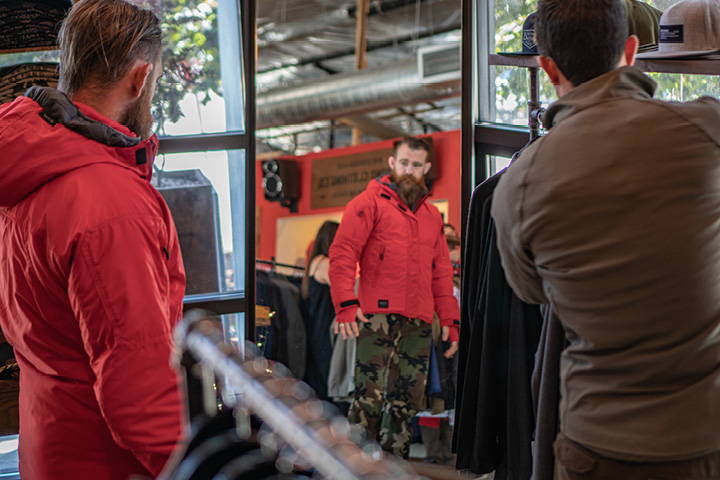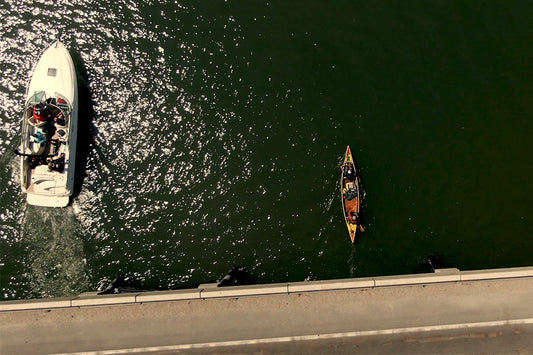Concerning Mountaineering Pointers
& the Return of Adventure
Matt Winslow and Josh Tyler of Savage Gentlemen were, like many of us, feeling frustrated and cooped up. “Josh and I were lamenting the fact that we couldn’t do anything or go anywhere,” Matt told us. “And we were like, ‘We need an adventure. Let’s go somewhere that people aren’t.’ And one of my favorite places to go is Rainier.” He and his cousin Mitch had summited Mt. Rainier via the Liberty Ridge route in the past, and had been feeling more than ready to take another crack at it through a different approach. Mitch was a time-tested partner, having climbed with Matt for roughly seven years. Josh, on the other hand, had not yet taken on a climb of this difficulty before. “This is not my first time on a mountain—I’ve summited some smaller ones—but this is my first big mountain, my first actual Alpine climbing experience,” Josh shared with us before the climb. Josh had his work cut out for him, and his guides were planning the best way to shape the experience. They decided upon the Kautz route; not as grueling as Liberty Ridge, but a definite challenge.
We invited all three to the BEYOND Acropolis to gear them up for the climb and pick their brains on mountain adventuring. Throughout all the shop talk, technical considerations, and small talk, one thing that was clear was a sense of anticipation. Not just for the new and challenging experience awaiting Josh, but in returning to adventure. All three were itching to get back out into the rough and get the heart rate up again. Caution and care were tempered with optimism and enthusiasm. “This is a big mountain,” Matt mused. “It’s easy to get overwhelmed on that mountain; a lot of stuff can go wrong. Especially when you’re getting to the ice-climbing portion at 12,000 feet, there’s stuff that happens, there’s stuff that can go wrong. But as long as I’ve known Josh, he’s got a very good quality in him, in that he doesn’t quit. He’ll let me know if it’s way outside his comfort zone, but if he’s just uncomfortable he’s gonna push through that. And that’s a very high quality.”
Our guests were generous enough to share a variety of considerations for aspiring mountaineers:
Get the Right System
This won’t come as a surprise if you’re already familiar with BEYOND, but putting together a system catered to your expedition destination is of the utmost importance. “It’s absolutely critical to have proper layers when you’re doing this sort of thing,” Matt confirmed. “What we’re doing is light and fast. We’ve got to be very selective about the layers that we wear. We can’t have any redundancies because they add weight. Weight slows you down, and speed is safety in the mountains. Mitch and I have extensive experience with clothing systems in cold-weather conditions, and we both went into this thinking, ‘Yup, this is what works, there’s nothing better than this.’ And when we got here at BEYOND, we were pleasantly surprised to find out yeah, there are some better ways of doing things.”
Double Your Boots
As important as your system is, you’re not likely to summit anything without a well-chosen array of accompanying equipment. Starting with two pairs of boots: “Boots are highly important. We’re climbing with a double boot, which is a boot within a boot,” Matt explained. “They’re extremely stiff-soled boots; they have a carbon-fiber layer. The reason you need that stiffness is twofold: one, it takes the pressure off your calves, because you’re not up on your toes. And number two: when you have crampons in, if you have any bend in that boot those crampons can pop off. And that’d be disastrous. Crampons—which are the spiky things that go on said boots—are your lifeline. We’re gonna be wearing them on the glacier fields when we’re going across snow. We’re also going to be using them on softer ice, and then once we get about 12,000 feet elevation we’ll be using them in harder ice. We’ll be using the front points to kick in and then make our way up.”
Know Your Gear
The popular images one might hold of mountaineering aren’t always accurate, Matt told us. “The ice tools that we’re taking on this are not like the mountaineering axe you’d see your grandpa using, the straight ones. They’re more of a technical tool; they have a big curve to them, and you use two of them instead of one. Being that the ice is steeper, we need those to successfully and safely navigate the ice.” Mitch added a few other fundamentals you’ll want to cover, and you’ll want to give them just as much attention: “Obviously you need your safety gear, like a helmet and a harness, and those aren’t things you want to skimp on or buy used. Then we have our protection systems: our ropes, our ice screws. For protecting some of the snow crossings we have snow pickets, which are like long metal rods that we can bury really deep and belay each other off of and safely cross snow bridges and steep snow inclines.”
Find the Right Pack
The pack you choose has a lot of say on how well your climb will go, in a lot of ways. And while there was excitement for the new packs they’d received courtesy of Mystery Ranch, there was some apprehension as well. “I will never turn down gear,” Mitch told us, “but at the same time, I have a system that works well for me. It’s fit to my body type, it’s extremely lightweight, and it does everything I need it to do. But as soon as we packed up the gear, I was finding little things that I really liked about these new packs. And then when we weighed them down they carried unbelievably well, just like a good pack should.” Josh continued, “That’s the tricky part. Whenever you’re doing something with new gear that you haven’t had a ton of experience with, there’s that break-in period: ‘How’s this gonna fit? How’s this gonna feel?’ And I feel like Mystery Ranch has done a great job solving those equations, giving it the customization ability to make it fit exactly where it needs to be.” With a bit of chuckle, Matt added: “It’s funny with packs. As far as climbing goes, you want it to do everything but have nothing on it. You’re kind of looking for the paradoxical pack at that point; you don’t want any excess but you want it to hold all of your stuff and make it all accessible.”
Plan Your Nutrition
It’s not enough to simply stock up on a few grocery store snacks and call it good. “Palate fatigue is a very real thing,” Josh explained. “A lot of people don’t factor that in, so they find something that they like and they get a ton of it. So if you’re a very savory person, it’s all salty meats, jerkies, and that sort of thing. Your body will only eat so much of that before it’s like, ‘Okay, we’re done, that’s it.’ So you have to counterbalance that with sweet. What you need to be able to do is balance and bounce back and forth to make sure that you can get enough calories in. Most of our lives, we never have a problem getting enough calories; in fact, we get way more than we will probably ever use. But when you’re in these kinds of environments, it’s very easy to under-eat.” Not all foods are going to be ideal for the punishing conditions of the mountainside either: “You can’t bring a frying pan and a pound of bacon just to sizzle up there on the mountain; it would be delicious, but not very practical. So, what’s nutrient-dense? What can we carry that’s lightweight, has the calories, and is tasty enough that we’ll actually enjoy eating it? We’ve got some freeze-dried food that we’ll cook up out there when we’re static, and then we’ve got quite a bit of salty and sweet snacks to eat as we’re moving.”
Develop Your Skill Set First
If you’ve never climbed a mountain before, don’t actually begin with trying to climb one. Build up your skills individually in more controlled settings. “Mitch and I didn’t start by climbing Mt. Rainier,” Matt confirmed. “We started rock climbing. We started in the gym. We started ice climbing. Having those more technical fundamentals of climbing under your belt really makes it easier when you’re battling fatigue, cold, and hunger. The cool thing about mountaineering—especially Alpine climbing, which is the style we’re doing—is it uses all those disciplines.” “I would say also,” Mitch joined in, “look for a mentor. You can learn so much on YouTube, but for stuff where I’m gonna put my life on the line? I’m either gonna look to somebody that is willing to train me. Look to somebody that has some skill and has a bit of a resume built up.” “In no world,” Josh agreed, “would I ever attempt something of this magnitude on my own or with someone of equal or lesser experience. The only reason I’m doing this is because I’ve got two guys who’ve been there and done that, and they can kind of—pardon the pun—show me the ropes.”
Keep an eye out for Part 2, where we’ll explore how the climb itself went!






0 Comments